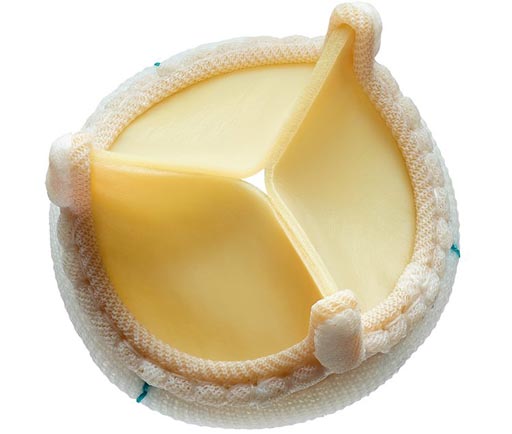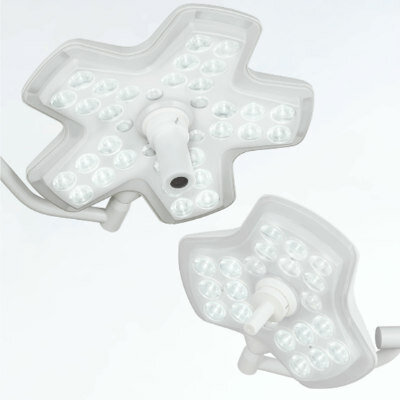Surgical Pericardial Valve Treats Aortic Valve Disease
|
By HospiMedica International staff writers Posted on 23 Aug 2017 |

Image: The Avalus stented surgical aortic valve (Photo courtesy of Medtronic).
A new bioprosthetic valve (BHV) provides innovative features designed to enhance clinical performance during aortic valve replacement.
The Medtronic (Dublin, Ireland) Avalus stented surgical aortic valve features a supra-annular design for excellent hemodynamic performance, intended to limit central regurgitation; an interior-mounted leaflet and frame designed to enhance durability; a low-profile valve design for easier placement; and a streamlined valve holder that includes a single, one-cut release in order to further facilitate ease of implantation. Avalus is also magnetic resonance imaging (MRI) safe, without restrictions.
“Medtronic is committed to advancing its surgical portfolio to offer cardiac surgeons a contemporary option to help meet the individual needs of this patient population,” said Rhonda Robb, vice president and general manager of Heart Valve Therapies business at Medtronic's. “By continuing to collaborate with leading cardiac surgeons around the world, we look forward to bringing heart valve replacement solutions like the Avalus valve to assist in expanding access and improving outcomes for clinical and patient communities.”
“The proven design elements of the Avalus valve were selected with physicians and patients in mind, striving to improve upon the latest generation of stented tissue valves while maintaining the gold standard in cardiac surgery,” said cardithoracic surgeon Robert Klautz, MD, of Leiden University Medical Center (The Netherlands). “Based on my early clinical experience, the unique design elements of the Avalus valve position it well toward meeting the expectations of durability for new tissue valves and helps ease implantation in a wide range of patient anatomies.”
BHVs are made of biologic tissues, making them safer to implant, functionally similar to the native aortic valve, and they do not require long-term anticoagulant therapy. The most commonly used BHVs are made from porcine aortic valves and calf pericardium. The valve tissue is sewn onto a fabric covered metal wire stent, made from a cobalt-nickel or another alloy. Dacron fabric covers the entire stent and a sewing skirt is fashioned and attached to the base of the wire stent.
The Medtronic (Dublin, Ireland) Avalus stented surgical aortic valve features a supra-annular design for excellent hemodynamic performance, intended to limit central regurgitation; an interior-mounted leaflet and frame designed to enhance durability; a low-profile valve design for easier placement; and a streamlined valve holder that includes a single, one-cut release in order to further facilitate ease of implantation. Avalus is also magnetic resonance imaging (MRI) safe, without restrictions.
“Medtronic is committed to advancing its surgical portfolio to offer cardiac surgeons a contemporary option to help meet the individual needs of this patient population,” said Rhonda Robb, vice president and general manager of Heart Valve Therapies business at Medtronic's. “By continuing to collaborate with leading cardiac surgeons around the world, we look forward to bringing heart valve replacement solutions like the Avalus valve to assist in expanding access and improving outcomes for clinical and patient communities.”
“The proven design elements of the Avalus valve were selected with physicians and patients in mind, striving to improve upon the latest generation of stented tissue valves while maintaining the gold standard in cardiac surgery,” said cardithoracic surgeon Robert Klautz, MD, of Leiden University Medical Center (The Netherlands). “Based on my early clinical experience, the unique design elements of the Avalus valve position it well toward meeting the expectations of durability for new tissue valves and helps ease implantation in a wide range of patient anatomies.”
BHVs are made of biologic tissues, making them safer to implant, functionally similar to the native aortic valve, and they do not require long-term anticoagulant therapy. The most commonly used BHVs are made from porcine aortic valves and calf pericardium. The valve tissue is sewn onto a fabric covered metal wire stent, made from a cobalt-nickel or another alloy. Dacron fabric covers the entire stent and a sewing skirt is fashioned and attached to the base of the wire stent.
Latest Surgical Techniques News
- Robotic Assistant Delivers Ultra-Precision Injections with Rapid Setup Times
- Minimally Invasive Endoscopic Surgery Improves Severe Stroke Outcomes
- Novel Glue Prevents Complications After Breast Cancer Surgery
- Breakthrough Brain Implant Enables Safer and More Precise Drug Delivery
- Bioadhesive Sponge Stops Uncontrolled Internal Bleeding During Surgery
- Revolutionary Nano Bone Material to Accelerate Surgery and Healing
- Superior Orthopedic Implants Combat Infections and Quicken Healing After Surgery
- Laser-Based Technique Eliminates Pancreatic Tumors While Protecting Healthy Tissue
- Surgical Treatment of Severe Carotid Artery Stenosis Benefits Blood-Brain Barrier
- Revolutionary Reusable Duodenoscope Introduces 68-Minute Sterilization
- World's First Transcatheter Smart Implant Monitors and Treats Congestion in Heart Failure
- Hybrid Endoscope Marks Breakthrough in Surgical Visualization
- Robot-Assisted Bronchoscope Diagnoses Tiniest and Hardest to Reach Lung Tumors
- Diamond-Titanium Device Paves Way for Smart Implants that Warn of Disease Progression
- 3D Printable Bio-Active Glass Could Serve as Bone Replacement Material
- Spider-Inspired Magnetic Soft Robots to Perform Minimally Invasive GI Tract Procedures
Channels
Critical Care
view channel
CPR Guidelines Updated for Pediatric and Neonatal Emergency Care and Resuscitation
Cardiac arrest in infants and children remains a leading cause of pediatric emergencies, with more than 7,000 out-of-hospital and 20,000 in-hospital cardiac arrests occurring annually in the United States.... Read more
Ingestible Capsule Monitors Intestinal Inflammation
Acute mesenteric ischemia—a life-threatening condition caused by blocked blood flow to the intestines—remains difficult to diagnose early because its symptoms often mimic common digestive problems.... Read more
Wireless Implantable Sensor Enables Continuous Endoleak Monitoring
Endovascular aneurysm repair (EVAR) is a life-saving, minimally invasive treatment for abdominal aortic aneurysms—balloon-like bulges in the aorta that can rupture with fatal consequences.... Read more
Wearable Patch for Early Skin Cancer Detection to Reduce Unnecessary Biopsies
Skin cancer remains one of the most dangerous and common cancers worldwide, with early detection crucial for improving survival rates. Traditional diagnostic methods—visual inspections, imaging, and biopsies—can... Read morePatient Care
view channel
Revolutionary Automatic IV-Line Flushing Device to Enhance Infusion Care
More than 80% of in-hospital patients receive intravenous (IV) therapy. Every dose of IV medicine delivered in a small volume (<250 mL) infusion bag should be followed by subsequent flushing to ensure... Read more
VR Training Tool Combats Contamination of Portable Medical Equipment
Healthcare-associated infections (HAIs) impact one in every 31 patients, cause nearly 100,000 deaths each year, and cost USD 28.4 billion in direct medical expenses. Notably, up to 75% of these infections... Read more
Portable Biosensor Platform to Reduce Hospital-Acquired Infections
Approximately 4 million patients in the European Union acquire healthcare-associated infections (HAIs) or nosocomial infections each year, with around 37,000 deaths directly resulting from these infections,... Read moreFirst-Of-Its-Kind Portable Germicidal Light Technology Disinfects High-Touch Clinical Surfaces in Seconds
Reducing healthcare-acquired infections (HAIs) remains a pressing issue within global healthcare systems. In the United States alone, 1.7 million patients contract HAIs annually, leading to approximately... Read moreHealth IT
view channel
Printable Molecule-Selective Nanoparticles Enable Mass Production of Wearable Biosensors
The future of medicine is likely to focus on the personalization of healthcare—understanding exactly what an individual requires and delivering the appropriate combination of nutrients, metabolites, and... Read moreBusiness
view channel
Philips and Masimo Partner to Advance Patient Monitoring Measurement Technologies
Royal Philips (Amsterdam, Netherlands) and Masimo (Irvine, California, USA) have renewed their multi-year strategic collaboration, combining Philips’ expertise in patient monitoring with Masimo’s noninvasive... Read more
B. Braun Acquires Digital Microsurgery Company True Digital Surgery
The high-end microsurgery market in neurosurgery, spine, and ENT is undergoing a significant transformation. Traditional analog microscopes are giving way to digital exoscopes, which provide improved visualization,... Read more
CMEF 2025 to Promote Holistic and High-Quality Development of Medical and Health Industry
The 92nd China International Medical Equipment Fair (CMEF 2025) Autumn Exhibition is scheduled to be held from September 26 to 29 at the China Import and Export Fair Complex (Canton Fair Complex) in Guangzhou.... Read more












